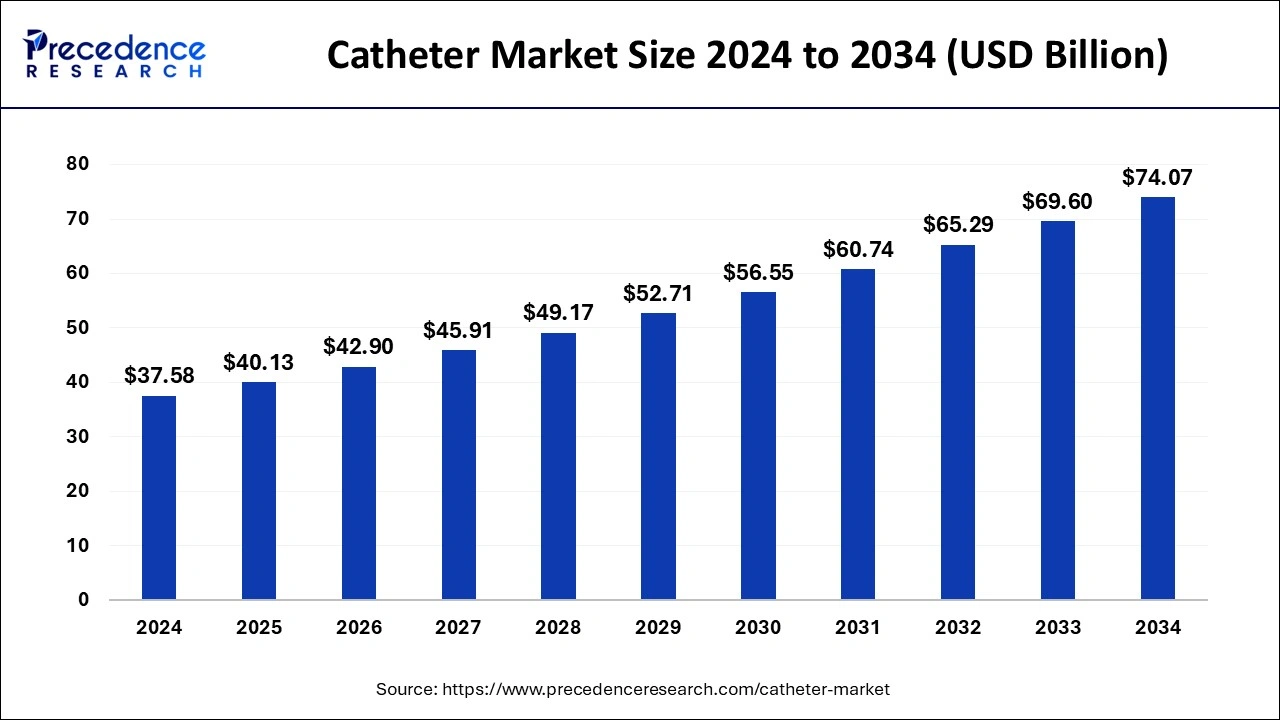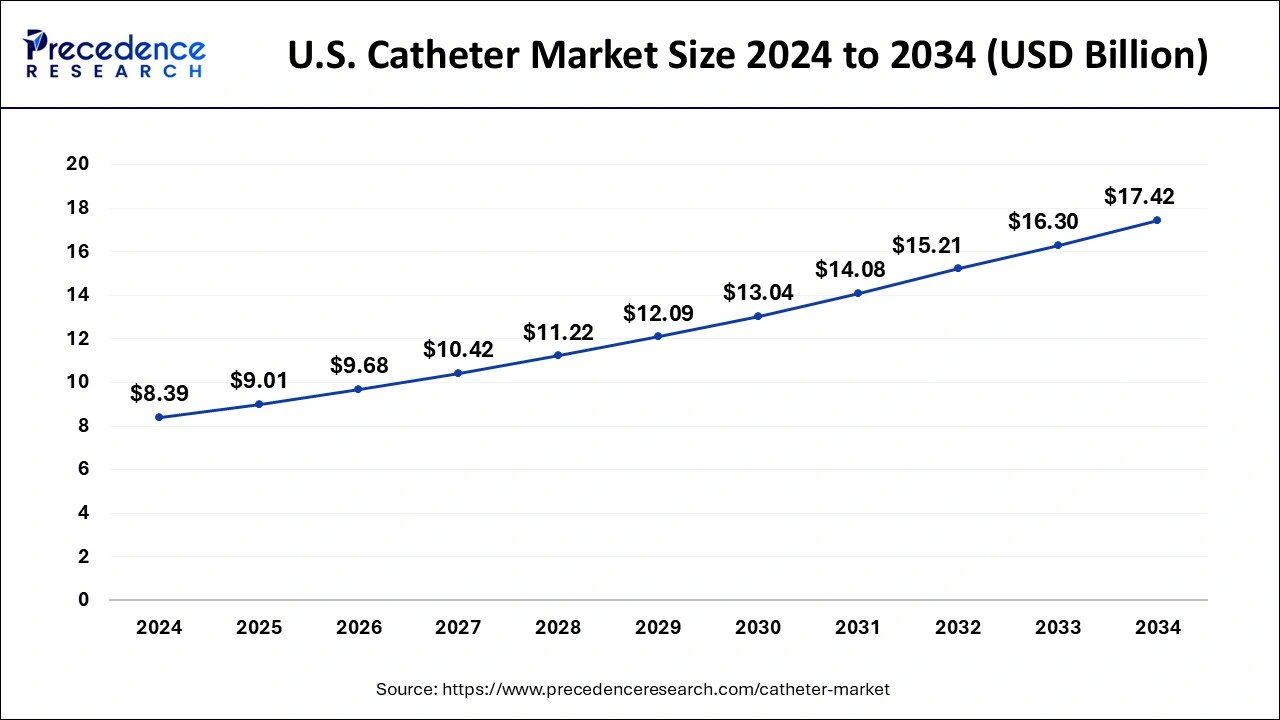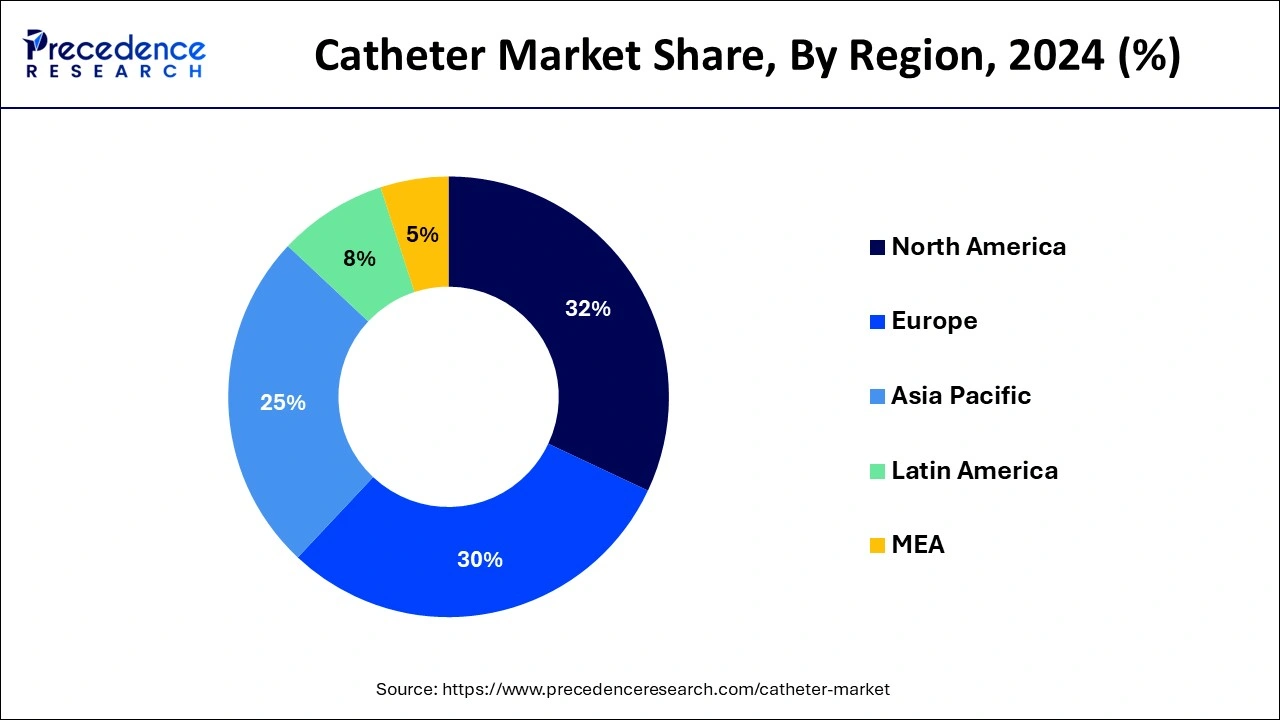December 2024
The global catheter market size is calculated at USD 40.13 billion in 2025 and is forecasted to reach around USD 74.07 billion by 2034, accelerating at a CAGR of 7.09% from 2025 to 2034. The North America catheter market size surpassed USD 12.03 billion in 2024 and is expanding at a CAGR of 7.12% during the forecast period. The market sizing and forecasts are revenue-based (USD Million/Billion), with 2024 as the base year.
The global catheter market size was estimated at USD 37.58 billion in 2024 and is anticipated to reach around USD 74.07 billion by 2034, expanding at a CAGR of 7.09% from 2025 to 2034. The increasing diabetic population, growing urological and cardiovascular disorders, incurable renal failure, and rest chronic conditions caused by changing or inactive lifestyles are projected to drive substantial growth in the catheter market.

Numerous aspects of healthcare delivery are being revolutionized by the market's adoption of automation and artificial intelligence (AI) in the catheter industry. Artificial intelligence (AI) is improving catheter design and production, leading to increased accuracy and fewer use-related issues. Hospital automated solutions are increasing overall efficiency, reducing human error, and simplifying catheter insertion procedures. Additionally, healthcare providers are benefiting from AI-based predictive analytics by using it to monitor patients more effectively and create customized treatment plans. This might result in better patient outcomes and shorter hospital stays, which would have a big impact on market dynamics.
The U.S. catheter market size was evaluated at USD 8.39 billion in 2024 and is predicted to be worth around USD 17.42 billion by 2034, rising at a CAGR of 7.66% from 2025 to 2034.

North America held the highest revenue share of 32% in the catheter market in 2024 owing to existence of global manufacturers and modern health care infrastructure. Further, supportive government policies and increasing awareness about the product will boost the demand for catheter market. Adoption of innovative technologies such as antimicrobial coating catheters, intravascular imaging catheters which will boost the growth of the catheter market in the region. According to National Public Health Institute in US around 9%of the population from America is diabetic.

Europe holds the second largest position in catheter market. In Europe France, Germany and UK significantly contribute to this regional market due to the technological advancement in the healthcare sector. Asia Pacific is expected to show fastest growth rate over the forecast period on account of continuously improving medical facilities and available target population affected by chronic diseases such as diabetes. Around 60% of the total global diabetic population present in Asia Pacific which will fuel the market growth. Owing to least availability of investment and medical treatments, Middle East and Africa experiences sluggish growth in the catheter market.
Silicon rubber, nylon, plastic, and polyvinyl chloride (PVC) are the materials used to make catheters, which are thin tubes. Catheterization is often utilized during surgical operations such as angioplasty and neurosurgery. The increase in the number of people with diabetes and cardiovascular diseases is driving this market's enormous growth. Due to a sedentary lifestyle and an increasing number of people who smoke and drink, many nations have seen an increase in the number of patients with diabetes and hypertension. Additionally, favorable reimbursement rules are increasing the need for minimally invasive procedures, and catheter technology is developing with great efficacy. Ultimately, the catheter market is being driven by all of these causes.
| Report Highlights | Details |
| Market Size in 2024 | USD 37.58 Billion |
| Market Size in 2025 | USD 40.13 Billion |
| Market Size by 2034 | USD 74.07 Billion |
| Growth Rate from 2025 to 2034 | CAGR of 7.09% |
| Largest Market | North America |
| Base Year | 2024 |
| Forecast Period | 2025 to 2034 |
| Segments Covered | Product Type, Distribution Channel, End User, Lumen, Type, Applications and Regional Scope |
Rising demand for antimicrobial catheters
Because catheters are frequently placed into the blood arteries of patients with chronic illnesses, who often have weakened immune systems, these patients are more susceptible to infection. In order to reduce the risk of thrombosis and infections linked to catheter use, more companies are focusing their efforts on creating antimicrobial catheters. In order to solve the increasing issues associated with catheter use, market participants are adding new functionalities to catheters. Consequently, the need for antimicrobial catheters is being driven.
The risk associated with catheters
Due to frequent catheter use, patients who have had catheter insertions are more likely to experience problems linked to catheter-related bloodstream infections (CABSI). Bloodstream infections linked to catheter use may potentially become more common as a result of this risk. It has been discovered that patients who have had catheter insertions are more likely to experience bloodstream infections due to catheter use, as well as related risks and problems.
Use of advanced materials
Catheters are made by businesses using advanced materials like polyurethanes and polycarbonates. In order to extend the life of catheters, Sorbothane, which is resistant to substances including iodine, hydrogen peroxide, and alcohol, are utilized throughout the production process. Furthermore, Durathane catheters provide the user with strength and resistance. Consequently, it is projected that the usage of cutting-edge materials in catheter manufacturing will raise end-user demand in the upcoming years.
Based on the product type the catheter market is segmented into cardiovascular catheter, urological catheter, neurovascular catheter, and intravenous catheter and specialty catheters. Among these, the cardiovascular catheter segment dominated the global market in 2024 and is expected to hold the dominance over the forecast period owing to continuous prevalence of cardiovascular diseases across the world. In Germany, the significant growth is observed in catheter market owing to the high prevalence of cardiovascular diseases along with the growing demand for less incision surgeries. According to European Union around 38% of the deaths accounted in the Germany owing to cardiovascular diseases. Nevertheless, the availability of cardiac special hospitals and the health care centers in the country will drive the catheter market growth. The cardiovascular segment is sub segmented into electrophysiology, PTA balloon, PTCA balloon, and Intravascular Ultrasound (IVUS) out of which the PTCA balloon sub segment is predicted to dominate the catheter market over the forecast period. Among the intravenous sub segments the peripheral catheter observed high demand and surgical catheter from specialty segment led the global catheter market.
In terms of distribution channel, the global catheter market is segmented into hospital stores, retail stores and other online stores. Out of these, hospital stores segment dominates the market owing to increasing surgeries and medical treatments which in result increase the number of patients to be hospitalized. The hospital stores are also expected to witness highest CAGR on account of increasing urinary incontinence and other chronic disorders. With increasing internet penetration, the e-commerce websites become popular for the catheter which will push customers to use online channels for purchase. Further, the retail stores are also expected to witness significant growth over the forecast period owing to the growing urological problems.
This research report involves complete evaluation of the market by means of vast qualitative and quantitative comprehensions, and projections regarding the market. This report offers breakdown of market into prospective and niche sectors. Further, this research study calculates market revenue and its growth trend at global, regional, and country from 2025 to 2034. This report includes market segmentation and its revenue estimation by classifying it based on end-use and region as follows:
By Product
By Distribution Channel
By End User
By Lumen
By Type
By Application
By Regional Outlook
For inquiries regarding discounts, bulk purchases, or customization requests, please contact us at sales@precedenceresearch.com
No cookie-cutter, only authentic analysis – take the 1st step to become a Precedence Research client
December 2024
September 2024
May 2024